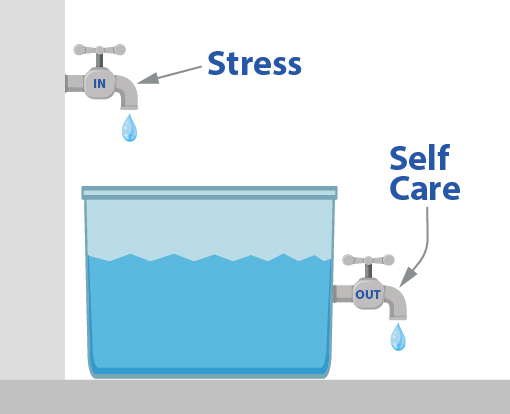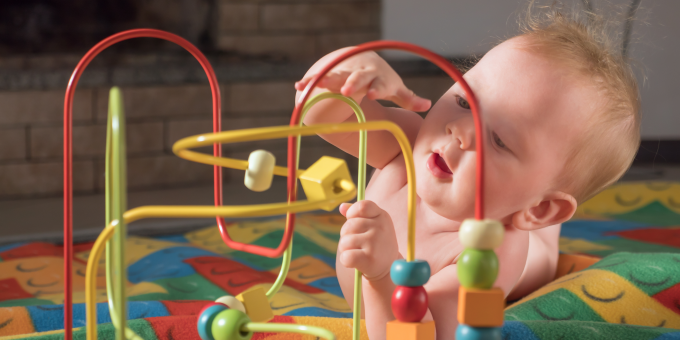
What is stress?
All of us deal with stress in our lives – it is a natural occurrence and one would be unreasonable to think that we can live completely stress free lives. In fact, a low amount of stress can be ideal. It can give us that push we need to accomplish things in our lives. That bit of fire under our feet so to say. However, when we have a large amount of stress it can be overwhelming to us and can impact us both physiologically as well as emotionally. This is when stress is no longer beneficial and is instead detrimental to our wellbeing. For more information on what stress is, you can refer to this blog post (https://blog.dynamics.com.sg/how-to-measure-stress-levels-according-to-psychology)
Here’s another way to put it, we all have a bucket that we are holding. This bucket contains our stress level. Now imagine the water flowing into your bucket are the different stresses in life. What are some things that stress you out? Our work, school, relationships, and what’s going on around us can add stress to our bucket. How much stress it may add varies on how stressful the situation is. An upcoming exam may add a lot of stress to our bucket; whereas, forgetting to write an email may cause only slight stress (however each person is different and may find those in reverse order of stress level). Our buckets can only hold so much stress before a bucket overflows and we fill overwhelmed and it can begin to impact on our physical/mental well being.

When we have high levels of stress that overflow our bucket, that’s when we can enter our flight or fight response. This is our body’s way of preparing to either face the thing causing our stress or to run from it. When we enter this state we have very physiological and mental changes that happen to us. You may notice that when you are stressed you feel hot or flushed. You may notice your heart is racing. Your breathing becomes shallow and quick. Your stomach may feel like a heavy ball is inside as your digestive system slows down. Your mouth may feel very dry, and your muscles feel tense. You may find it hard to think or find your words. This is your body’s way of preparing the body for flight or fight. This is a normal bodily reaction; however, this can be very draining on the body; especially if we experience this repeatedly. It is important to remember that when in a state of flight or fight, your child may have difficulty listening to your logical explanation of why they should calm down just as you would when you are highly stressed. We will discuss this more below.
How can we manage our stress?
It is important that we find ways to help lower the stress levels in our bucket. We can do that by letting out some stress through different activities that are meaningful and provide self-care to ourselves. Remember our stress bucket? Well, it has a nozzle at the base and when we do self-care activities this helps let out a bit of stress each time. This is why it is important for both children and adults to have activities in their daily life that are enjoyable and fun. Whether this is having some quiet time for yourself, participating in a hobby, meeting up with friends and loved ones, or practicing mindfulness and/or relaxation techniques.
You can help manage your stress by setting aside time in your day/week/month as part of your routine. It is easy to drop the things that make us feel relaxed in priority for the things causing us stress. However, we need to have those enjoyable things so that we can manage our stress and not let it overwhelm us. Think of what activities you may be able to do every day, once a week, and once or twice a month to help you enjoy your time a bit more and prevent your stress bucket from overflowing. Having a discussion with your child on what they find calming and enjoyable can be a great way to help them engage in these activities when they are stressed. These are things that can be done regularly to help keep their stress more manageable.
However, there are times when our bucket is close to overflowing or is overflowing and we are in our fight and flight mode. When this happens, it can be hard to think in the moment of what to do to help us relax. This is why it can be useful to find strategies beforehand that we already know how to do to help us relax. It could be reaching out to a friend/loved one, going for a walk, enjoying a bath, or using a specific relaxation technique. When helping a child calm down (when in a heighted stress moment), you should remember to use calm, gentle tone and short, simple words/phrases. Just like adults, they will have trouble taking in information and processing it logically. Instead we need to help them calm down with a soothing relaxation technique to let their flight or fight response calm down so they feel safe again.
What are relaxation techniques?
Relaxation techniques are things that help us to increase the awareness of our body while allowing us to distract us from our thoughts that may be racing. This can create a feeling of calm within us. It can be hard at first to engage in these techniques as they require us to be in the moment and still. It is beneficial to try these in small amounts and build up doing them for longer time. You may find that you can only do a relaxation technique for 3 minutes. That’s okay! That was 3 minutes you were able to focus on you and build this exercise technique up. Keep trying and building this skill! Explore the different techniques as you may find that one is easier to connect with than some of the others.
Good examples of relaxation techniques are: guided imagery, mindfulness, progressive muscle relaxation (PMR), autogenic relaxation, deep breathing, and mediation. You can also explore yoga and tai chi as relaxation techniques. There are many ways to learn how to do these techniques. You can try learning through online means or you can reach out to a trained professional (psychologist, occupational therapist, yoga/tai chi instructor) to help guide you through the process and find which technique works best for you.
Relaxation Technique Example:
Have a try at following this Progressive Muscle Relaxation (PMR) script. You can either read it to yourself or read it aloud for your child to help them learn a new relaxation technique! If needed, you can take longer or shorter pauses as you read it to help your child be able to follow along. Please remember to remind your child to only tense their muscles up to the point of feeling it tight, but not feeling pain. You may need to demonstrate to your child the first time so they can see and understand.
Find yourself in a comfortable position. You may find yourself lying on the floor, legs straight out. Or in a chair with feet flat on the ground, hands resting gently on your lap. If you feel comfortable, you can close your eyes and let them rest.
Take this moment to take a deep breath in through your nose and slowly let it out through your mouth. Take another deep breath through your nose and feel your tummy get bigger as you do. Slowly let it out through your mouth and let your tummy relax.
Slowly become aware of your toes all the way at the bottom of your body. Have a wiggle of your toes and then begin to point your toes up towards your knees. Feel the tightness building in your feet and calves. Your feet, ankles and calves beginning are beginning to get tired… and let go. Let your toes rest. Feeling the tightness go away, leaving your feet and calves feeling heavy and warm.
Then slowly tense the top of your legs. Feeling the tightness build at your knees and the front and back of your legs. Your legs are beginning to get tired…and let go. Let your legs rest. Feeling the tightness go away, leaving your legs feeling heavy and warm.
Now slowly take a deep breath in through your nose. As you breathe out through your mouth, suck your tummy in. Feeling your tummy and back tighten. You tummy and back are beginning to get tired… and let go. Let your tummy relax back into the floor or chair. Feeling the tightness go away, leaving your tummy and back feeling heavy and warm.
Move your attention to your hands. Slowly make a fist and tighten your fist, making sure not to dig your fingernails into your palm. Only tense to the point you feel tightness, not pain. Now slowly bring your fists up to your shoulders and hold them there. Feel the tightness build in your hands and go up your arms to your shoulder. Your hands and arms are beginning to get tired… and let go. Let you hands slowly relax back down to your sides. Letting your fingers relax. Feeling the tightness go away, leaving your hands and arms feeling heavy and warm.
Take a deep breath in through your nose and hold it. Don’t exhale yet. Let the tightness build in your chest and then exhale through your mouth. Letting the tension go, and letting your chest sink back down and relax. Feeling the tightness go away, leaving your chest feeling heavy and warm.
Slowly move your attention to you shoulders and neck. Take a deep breath in through your nose, and as you exhale through your mouth let your shoulders raise up to touch your ears. Feeling the tightness building in your shoulders and neck. Inhale deeply again, and as your exhale let your shoulders relax. Feeling the tightness go away, leaving your shoulders and neck feeling heavy and warm.
Now slowly lower your chin to your chest. Holding it there as you feel the tightness building in your neck. Let your chin come back to its natural position. Feeling your neck relax as you do. Letting the tightness go away, leaving your neck feeling heavy and warm
Then turn your attention to your face. Scrunch up your face as tight as you can without causing pain. You may squeeze your eyes shut and press your tongue to the roof of your mouth. Or, you may try sticking your tongue out as far as you can while scrunching your nose. As you do, feel the tightness building in your face. Hold it there for a bit longer. And, then slowly let your face relax. Feeling the tightness go away, leaving you face feeling heavy and warm.
Take another deep breath in through your nose and exhale slowly through your mouth. Just rest for a moment. Enjoying the heavy, warm feeling of your body. Take one more deep breath, and exhale. When you’re ready open your eyes and become aware of your surroundings. Now feeling relaxed and ready to carry on your day.
If you enjoyed that relaxation technique you can keep using it and building that skill up. If you didn’t care for it, don’t worry! There are other relaxation techniques out there as previously mentioned that may be a better fit. A trained professional like an occupational therapist or a psychologist can help you find the relaxation technique that is a better fit for you. In fact, if you or your child is struggling with stress and finding it overwhelming, an occupational therapist can better help you or your child address your stress to find ways to help manage the stress levels. The occupational therapist can do so by looking at the different areas of you or your child’s life that may be overflowing your bucket, and work together to find, teach, and/or recommend strategies that will help lower the stress levels in your bucket.
References:
Butler DS, Moseley GL 2003 Explain Pain Second edition (2013) Noigroup Publications, Adelaide.




